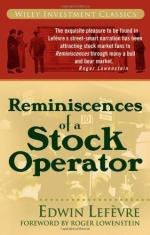
|
| Name: _________________________ | Period: ___________________ |
This test consists of 15 multiple choice questions and 5 short answer questions.
Multiple Choice Questions
1. What is an important aspect of trading successfully?
(a) Having patience and waiting for the right moment.
(b) Being willing to bet on even odds.
(c) Having enough money.
(d) Having good advice.
2. What happens when the market falls steeply in 1906?
(a) The government takes over the market.
(b) There is a depression.
(c) The banks collapse.
(d) It earns Livingston and his house a lot of money.
3. Why should a trader start with a small trade?
(a) So he'll lose less money.
(b) To see what others are doing.
(c) To see if it's going in the right direction.
(d) To find out if the stock is viable.
4. What's the difference between working on the stock exchange and the bucket shops?
(a) In bucket shops you only bet on a stock; in Wall Street you buy it.
(b) Wall Street requires you to wear a suit and tie.
(c) Bucket shops require more money.
(d) Bucket shops are run by the mob.
5. What does Livingston say will happen in a stock or commodity if a surprise event occurs?
(a) It will always go down.
(b) It will move in the direction of the market.
(c) It will always stay the same.
(d) It will always go up.
6. Who convinces Livingston that Union Pacific is manipulating him?
(a) His best friend.
(b) The branch manager.
(c) His wife.
(d) His mentor.
7. What do customers at a bucket shop do?
(a) Buy stock.
(b) Play the lottery.
(c) Bet on a stock going up or down.
(d) Buy feed buckets.
8. What does Livingston finally begin to study?
(a) Longer-term stock movements.
(b) Trading on margin and call.
(c) Mutual funds.
(d) Bond and index funds.
9. When is there a financial panic in 1907?
(a) August.
(b) October.
(c) April.
(d) June.
10. What does Livingston say to do with anything showing a loss?
(a) Sell it after it moves in either direction.
(b) Buy more of it.
(c) Hold it until it goes up.
(d) Sell it immediately.
11. What is Livingston's job at a bucket shop?
(a) Quotation boy.
(b) Stock broker.
(c) Trader.
(d) Runner.
12. How old was Livingston when he made his first $1000?
(a) 21.
(b) 17.
(c) 15.
(d) 19.
13. What happens shortly after he starts selling Union Pacific stock by the thousands?
(a) The San Francisco fire.
(b) The San Francisco tidal wave.
(c) Nothing happens.
(d) The San Francisco earthquake.
14. According to Livingston why should no one trade every day?
(a) It's not good for the soul.
(b) It is too tiring.
(c) It cost too much money.
(d) The excitement leads to mistakes.
15. What does Livingston decide from the Union Pacific situation?
(a) To listen more carefully to his manager.
(b) To practice understanding insider actions.
(c) To go back to school to learn more.
(d) To only trust himself.
Short Answer Questions
1. How much money does Livingston have when he goes to Wall Street?
2. How much money did Livingston make on the Union Pacific sell off?
3. Where does Livingston go with his $500?
4. Why does it take Livingston so long to understand how to trade?
5. Why can bets be carefully timed in bucket shops?
|
This section contains 519 words (approx. 2 pages at 300 words per page) |

|




